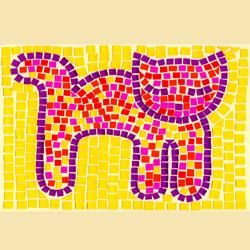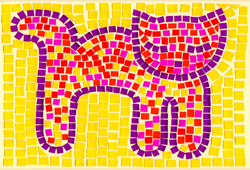Context and analysis of the work
Context
In 52 BC, the Romans settled in Gaul and tried gradually to get the Gauls to accept their presence. How? Through military domination of course, but primarily by allowing them to discover their rich culture and diverse arts.
The art of mosaic therefore established itself bit by bit in Gaul. The technique – mastered by Roman mosaicists and continually changing – appealed to “local Gaul artists” over the centuries. They in turn were inspired by Roman or Greek mosaics to create lasting works that were just as refined. The new “Gallo-Roman civilisation” came to light in the heart of Gaul...
At the start of the 3rd century, on the banks of the Rhône in Saint-Romain-en-Gal, mosaicists from the city of Vienne created a magnificent mosaic with the theme of the agricultural calendar. This was a faithful and perfect copy of a very specific Roman artwork, with just two other “copies” on the same theme in existence in the world...
Analysis of the work
1. In terms of form
Exhibited at the Musée de St Germain-en-Laye (Île-de-France), the agricultural calendar mosaic from the site in Saint-Romain-en-Gal (Rhône) was discovered in 1891. It adorned the floor of a sumptuous villa in a residential district of the time. This is what is called a mosaic pavement.
This mosaic consisted of 40 tableaux. Currently, 27 can be seen. Four of them, located at the extreme south of the mosaic, were damaged during a fire.
Original format: 8.86 m x 4.48 m.
The theme of the agricultural calendar is not frequently taken on by mosaicists. Furthermore, just two other mosaics in the spirit of Saint-Romain-en-Gal have been discovered:
• In El-Jem, Tunisia.
• In Zliten, Libya.
The Saint-Romain-en-Gal has the largest number of paintings.
2. In terms of technique
The agricultural calendar mosaic was made using tesserae, which are small pieces carved from glass paste, marble and limestone. The tesserae forming the various tableaux of the seasons are 3 to 5 mm square. Those that make up the background of the mosaic are slightly larger at 1 cm square. To assemble the mosaic, the tesserae are inserted one after the other into fresh mortar.
The top of the mosaic consists of a particular aesthetic and refined double border. The first – fine and neat – comprises a frieze of beads and whirls, unheard of in Vienne mosaics. The second – which is larger – is in the form of a polychrome plant arabesque. This features the long, indented acanthus leaf, typical of the Rhône-Alpes region.
Lastly, the various paintings are in turn separated by an ornamental border representing a braid formed of round grains and small domed discs in the middle.
In terms of colours, shades of red, ochre, orange and yellow can be seen... A colour palette relating to the “earth” and by extension its work.
3. In terms of significance
The Saint-Romain-en-Gal agricultural calendar mosaic is structured around panels featuring the four seasons. To “read” it, you need to start in the centre with the four tableaux depicting the four seasons.
Each season is personified by a mocking angel with chubby cheeks called “putto”, riding a different wild animal:
- Winter is riding a wild boar and looking North.
- Spring, astride a bull, looking South.
- Summer is riding a lion and pointing towards the South.
- Autumn is on a tiger and looking towards the North.
Around each seasonal panel are seven other tableaux:
a) For winter
• Bean seeds
• Grinding wheel
• Carrying manure
• Bread oven
• Sacrifice to Lares
• Basket weaving
• Festival of the dead (Parentalia, from 13 to 21 February)
b) For spring
• Return of the storks
• Tree grafting
+ 5 tableaux that have disappeared
c) For summer
• Sacrifice to Taranis
• Javelin thrower
• Collecting wood
+ 4 paintings that have disappeared
d) For autumn
• Apple picking
• Harvest
• Grape trampling
• Ploughing and sowing
• Pitching jars of oil
• Olive picking
• Olive pressing
Lastly, on the north and south extremities of the mosaic are four other paintings. Missing from the south side, the four paintings on the northern extremity represent the heads and lower parts of plants to signify the spring and summer.
4. In terms of use
A far cry from the mythological images and still lifes usually found at the time in mosaic pavements, the agricultural theme of the Saint-Romain-en-Gal mosaic is striking in terms of its rustic aspect and its unusualness.
The mosaic portrays major religious festivals, everyday activities and farming activities in an effective and original way. Far from seeking the Greek ideal, the mosaicists here have sought to represent as faithfully as possible the simplicity of everyday life. This is called “plebeian” art, which means that it depicts people but from a primarily scenic angle.
This is a means of extolling the praises of agricultural work and glorifying divine power through its religious rituals...



